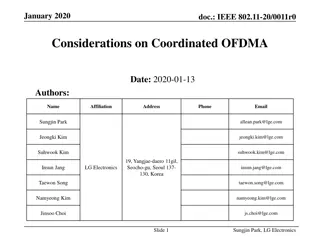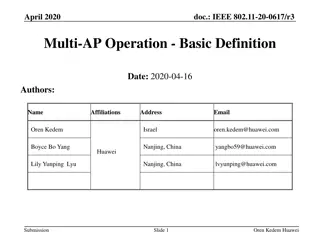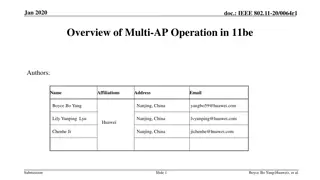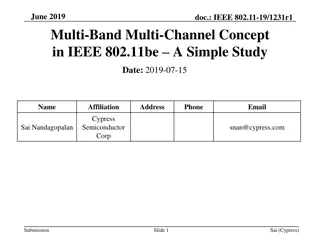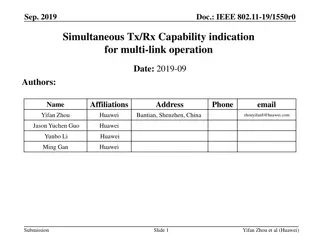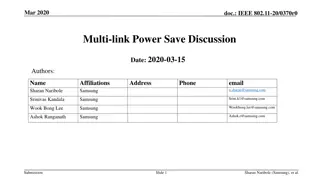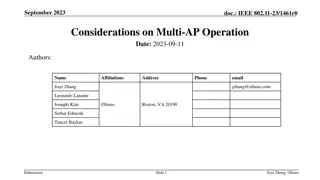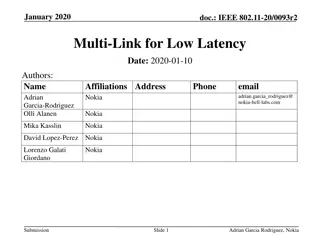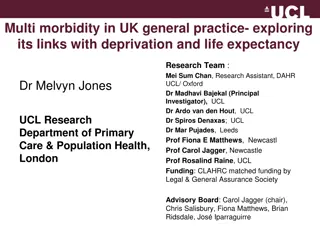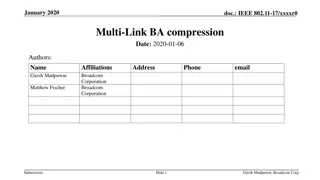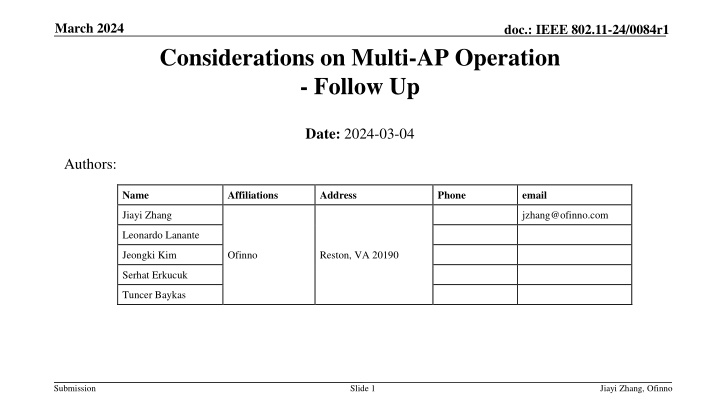
Multi-AP Operation Considerations in IEEE 802.11-24/0084r1 Document
Explore considerations for multi-AP operation in IEEE 802.11-24/0084r1 document, focusing on enhancing Ultra High Reliability (UHR) capabilities, transmission schemes, and coordination phases. Learn about the selection process, transmission schemes, and coordination procedures for effective multi-AP functionality.
Download Presentation

Please find below an Image/Link to download the presentation.
The content on the website is provided AS IS for your information and personal use only. It may not be sold, licensed, or shared on other websites without obtaining consent from the author. If you encounter any issues during the download, it is possible that the publisher has removed the file from their server.
You are allowed to download the files provided on this website for personal or commercial use, subject to the condition that they are used lawfully. All files are the property of their respective owners.
The content on the website is provided AS IS for your information and personal use only. It may not be sold, licensed, or shared on other websites without obtaining consent from the author.
E N D
Presentation Transcript
March 2024 doc.: IEEE 802.11-24/0084r1 Considerations on Multi-AP Operation - Follow Up Date: 2024-03-04 Authors: Name Affiliations Address Phone email Jiayi Zhang jzhang@ofinno.com Leonardo Lanante Jeongki Kim Ofinno Reston, VA 20190 Serhat Erkucuk Tuncer Baykas Submission Slide 1 Jiayi Zhang, Ofinno
March 2024 doc.: IEEE 802.11-24/0084r1 Abstract In PAR of P802.11bn, the Ultra High Reliability (UHR) capability has been defined to improve Rate-vs-Range enhancement, reduce latency, and reduce power consumption for AP, compared to Extremely High Throughput (EHT) MAC/PHY operation. Multi-AP operation (aka. Multi-AP coordination/transmission) has been discussed as one of the key candidate features to meet the requirement of UHR capability. In this contribution, we share some considerations on multi-AP operation, including the support of selecting multi-AP transmission schemes and the support of scheduling the multi-AP transmission. Submission Slide 2 Jiayi Zhang, Ofinno
March 2024 doc.: IEEE 802.11-24/0084r1 Recap: Multi-AP Operation [1~8] Multi-AP operation may include several phases/procedures between overlapping basic service sets (OBSSs). Multi-AP operation procedures may be performed as long-term or short-term operations: Long-term operation: e.g., one or more beacon interval level Short-term operation: e.g., one or more transmission opportunity (TXOP) level The multi-AP transmission may be carried in a multi-AP data transmission phase, preceded by one or more multi-AP coordination phases, including a multi-AP selection phase. Some multi-AP operation procedures may repeat optionally for follow-up or new transmissions. for long-term operation for short-term operation for short-term operation for short-term operation for short-term operation Multi-AP transmission Multi-AP coordination Multi-AP coordination Multi-AP transmission Multi-AP setup (channel sounding, UL/DL schemes: CSR, CTDMA, COFDMA, CBF, JT/JR, etc.) (AP candidate grouping/set, info exchange, etc.) (info exchange, AP selection, channel sounding, data sharing, etc.) (follow-up, or new) (follow-up or new) Submission Slide 3 Jiayi Zhang, Ofinno
March 2024 doc.: IEEE 802.11-24/0084r1 Multi-AP Transmission Scheme Selection The multi-AP selection phase may include frame exchanges to allow a sharing AP (AP1) to determine whether a candidate shared AP (AP2) may participate in a multi-AP transmission. However, the existing procedure relies on the sharing AP determining a multi-AP transmission scheme without consideration of whether the selected scheme can be adequately performed by the shared AP. Solution The sharing AP and/or the shared AP may support more than one multi-AP transmission schemes. The shared AP (AP2) provides the sharing AP (AP1) a preferred multi-AP transmission scheme. The sharing AP may consider the preferred multi-AP transmission scheme when selecting a multi-AP transmission scheme by the sharing AP. The sharing AP announces to the shared AP the multi-AP transmission scheme. Multi-AP selection phase Multi-AP data transmission phase Multi-AP data transmission phase Multi-AP sounding phase (e.g. using CSR (e.g. using JT) Multi-AP data sharing phase Multi-AP Response selection Confirm AP 1 (sharing AP) Feedback Request AP 2 (shared AP) STA 1 STA 2 Submission Slide 4 Jiayi Zhang, Ofinno
March 2024 doc.: IEEE 802.11-24/0084r1 Multi-AP Transmission Scheduling After a sharing AP (AP1) selects a shared AP (AP2) for a multi-AP transmission, the shared AP may become unavailable before the beginning of the multi- AP data transmission phase. (e.g., AP power saving) Solution 1: Shared AP Unavailability Window The shared AP (AP2) signals to the sharing AP (AP1) an unavailability window, during which the shared AP is unavailable to participate in a multi-AP transmission. The sharing AP schedules the multi-AP transmission to avoid the unavailability window of the shared AP. Solution 2: Multi-AP Transmission Window The sharing AP (AP1) signals to the shared AP (AP2) a multi-AP transmission window. The shared AP responds the sharing AP a decision of participating or not in the multi-AP transmission window. Multi-AP data transmission phase Multi-AP selection phase Multi-AP Multi-AP selection Confirm trigger AP 1 (sharing AP) Data AP2's unavailability window for multi-AP transmission Feedback AP 2 (shared AP) Data STA 1 BA STA 2 BA T0 T1 T2 Submission Slide 5 Jiayi Zhang, Ofinno
March 2024 doc.: IEEE 802.11-24/0084r1 Summary In this contribution, we shared some thoughts on multi-AP operation. We proposed the method of selecting multi-AP transmission schemes and methods of scheduling the multi-AP transmission. Submission Slide 6 Jiayi Zhang, Ofinno
March 2024 doc.: IEEE 802.11-24/0084r1 Q&A Discussion (Sept. 2023) C: The sharing AP will give the shared AP some notification. For confirmation frame, it could simplify the case. We don t need to have confirmation frame. It can help AP2 know it is selected. Multi-AP trigger fame serves the same function. A: Yes, it could be merged with the multi-AP trigger frame. This is an example shows the selection phase. There may be other examples. Submission Slide 7 Jiayi Zhang, Ofinno
March 2024 doc.: IEEE 802.11-24/0084r1 Straw Poll 1 Do you support the following text? The TGbn will allow more than one multi-AP transmission schemes in multi-AP operation. Note: the multi-AP transmission schemes may include but not limited to C-TDMA, CBF, CSR, C-FDMA, JT/JR, etc. Yes No Abstain Submission Slide 8 Jiayi Zhang, Ofinno
March 2024 doc.: IEEE 802.11-24/0084r1 Straw Poll 2 Do you support the following text? A shared AP may provide a sharing AP a preferred multi-AP transmission scheme of the shared AP, when the shared AP supports more than one multi-AP transmission schemes. Note: the multi-AP transmission schemes may include but not limited to C-TDMA, CBF, CSR, C-FDMA, JT/JR, etc. Yes No Abstain Submission Slide 9 Jiayi Zhang, Ofinno
March 2024 doc.: IEEE 802.11-24/0084r1 Straw Poll 3 Do you support the following text? A sharing AP may coordinate with a shared AP an availability/unavailability period used for performing a multi-AP transmission. Yes No Abstain Submission Slide 10 Jiayi Zhang, Ofinno
March 2024 doc.: IEEE 802.11-24/0084r1 References 1. IEEE 802.11-18/1982r1, Consideration on multi-AP coordination for EHT 2. IEEE 802.11-19/0448r1, Multi-AP transmission procedure 3. IEEE 802.11-19/1102r0, A unified transmission procedure for multi-AP coordination 4. IEEE 802.11-19/1129r2, Consideration-on multi-AP coordination 5. IEEE 802.11-19/1143r3, Efficient operation for multi-AP coordination 6. IEEE 802.11-19/1895r2, Setup for multi-AP coordination 7. IEEE 802.11-20/0596r1, AP candidate set follow-up 8. IEEE 802.11-20/0617r3, Multi-AP operation basic definition 9. IEEE 802.11-22/1512r0, Multi-AP coordination for UHR 10. IEEE 802.11-22/1515r0, A candidate feature multi-AP 11. IEEE 802.11-22/1530r1, Multi-AP coordination for next-generation Wi-Fi 12. IEEE 802.11-22/1899r0, Multi-AP operation for low-latency traffic delivery follow-up 13. IEEE 802.11-23/0226r2, Coordination of R-TWT for multi-AP deployment 14. IEEE 802.11-23/0293r0, Follow-up on TWT-based multi-AP coordination 15. IEEE 802.11-23/0297r0, R-TWT for multi-AP 16. IEEE 802.11-23/0860r0, Further thoughts on coordinated-TWT 17. IEEE 802.11-23/1449r1, UHR SG September 2023 Meeting Minutes Submission Slide 11 Jiayi Zhang, Ofinno

